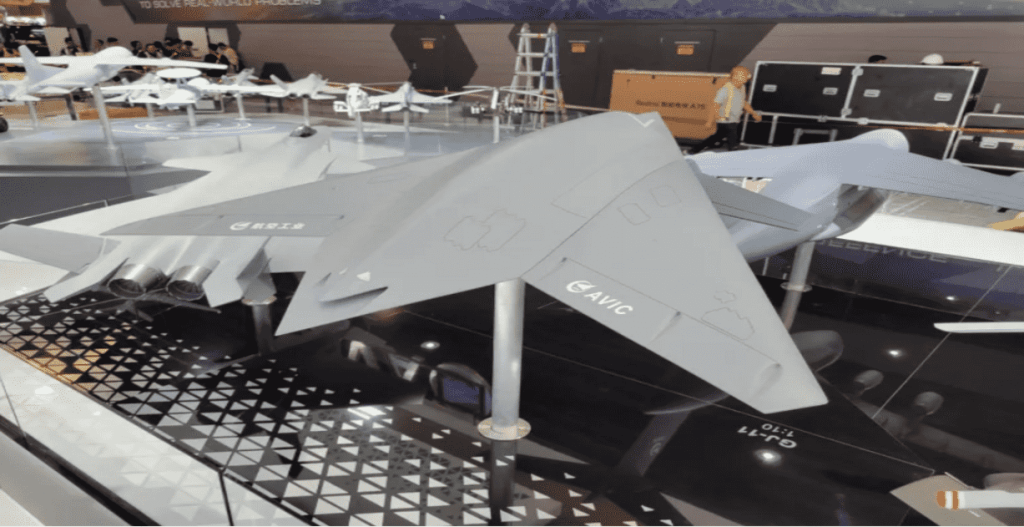China Unveils Powerful GJ-11 Sharp Sword UCAV at Singapore Air Show

China has unveiled its GJ-11 Sharp Sword unmanned combat aerial vehicle (UCAV) at the ongoing Singapore Air Show, showcasing its advanced military technology. This drone, often referred to as the J-20’s ‘loyal wingman,’ is expected to operate from the latest Type 004 Fujian carrier.
The fact that a mock-up of the GJ-11 was spotted on a full-sized carrier test facility last year indicates its potential significance in China’s naval warfare. However, its appearance at an international defense exhibition suggests a commercial motive as well. It seems that the Aviation Industry Corporation of China (AVIC) is keen on showcasing its technological capabilities to attract potential customers.
Regardless of the intentions behind its display, the GJ-11’s presence highlights the People’s Liberation Army Navy’s (PLAN) ambitious pursuit of becoming the first navy to deploy a carrier-launched UCAV. This development is worth noting as it could have significant implications for future naval operations.
The GJ-11 was officially unveiled during a military parade in October 2019, commemorating the 70th anniversary of the People’s Republic of China. Since then, it has been regarded as a formidable rival to the US stealth RQ-170 Sentinel drone. Manufactured by AVIC, the initial photos only provided limited views of the drone mounted on a truck during the parade.
However, subsequent images revealed a different design, with a larger top air intake and distinct exhaust nozzle. A scale model displayed at an air show in China showcased the drone’s two internal belly weapons bays, which were open between the side landing gears. Experts speculate that the GJ-11 is capable of carrying various types of precision ammunition, including larger ones that were not exhibited at the air show.
Overall, the unveiling of the GJ-11 at the Singapore Air Show highlights China’s advancements in military technology and its aspirations to dominate naval warfare. Whether for commercial purposes or strategic military objectives, this drone represents a significant step forward for the Chinese military.
The latest photograph of the scale model showcased at the Singapore Air Show offers a more detailed view of its unique flat exhaust nozzle, which is specifically designed to minimize its infrared signature.
In another intriguing development, a computer-generated concept image of the GJ-11 has been making waves on social media. This image reveals a bottom view of the aircraft releasing what appears to be a glide bomb from one of its internal weapons bays located underneath its belly.
Based on these observations, it is reasonable to assume that the drone possesses a limited Intelligence Surveillance and Reconnaissance (ISR) capability. This aligns with China’s broader strategy of incorporating advanced targeting information generation and data linking capabilities into all their airborne assets as part of their ‘intelligentized warfare’ concept.
Notably, Chinese military aviation expert Andreas Rupprecht shared a picture last year that depicted a land-based mock aircraft carrier facility in Wuhan. This facility featured mock-ups of various aircraft, including the J-15, J-35/J-31/FC-31 Gyrfalcon, KJ-600, and the GJ-11 on its flight deck.
Another expert from the People’s Liberation Army (PLA), Rick Joe, described this as a “near confirmation” that a “flying wing UAV/UCAV is intended for carrier aviation.” He further suggested that the GJ-11 is likely already undergoing testing.
In October 2022, a video surfaced claiming to show the GJ-11 in flight. However, a closer analysis by EurAsian Times concluded that it was actually the CH-7 Rainbow reconnaissance-strike UAV. There were also claims that it could be the H-20 bomber.
It is highly probable that the UCAV is intended to operate from Chinese carriers equipped with flat-top flight decks, such as the Type 004 Fujian. There is no indication that it will operate from carriers like the Liaoning or the Shandong, which have ski-jumps. This is evident from the resemblance of the carrier on which the full-scale model was placed to the Fujian.
Furthermore, both the Shandong and Liaoning carriers utilize Short-Take Off Barrier Arrested (STOBAR) launch and recovery systems, which require aircraft to take off using their own power from the ski-jumps.


